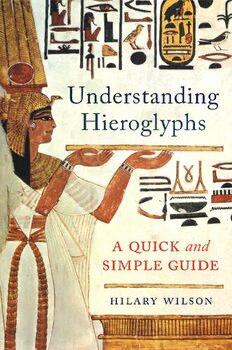
Understanding Hieroglyphs: A Quick and Simple Guide PDF
Preview Understanding Hieroglyphs: A Quick and Simple Guide
Understanding Hieroglyphs Understanding Hieroglyphs A QUICK and SIMPLE GUIDE HILARY WILSON Michael O’Mara Books Limited This new edition first published in 2019 First published in Great Britain in 1993 by Michael O’Mara Books Limited 9 Lion Yard Tremadoc Road London SW4 7NQ Copyright © 1993, 2019 Hilary Wilson All rights reserved. You may not copy, store, distribute, transmit, reproduce or otherwise make available this publication (or any part of it) in any form, or by any means (electronic, digital, optical, mechanical, photocopying, recording or otherwise), without the prior written permission of the publisher. Any person who does any unauthorized act in relation to this publication may be liable to criminal prosecution and civil claims for damages. A CIP catalogue record for this book is available from the British Library. Papers used by Michael O’Mara Books Limited are natural, recyclable products made from wood grown in sustainable forests. The manufacturing processes conform to the environmental regulations of the country of origin. ISBN: 978-1-78929-107-0 in hardback print format ISBN: 978-1-78929-108-7 in ebook format 1 2 3 4 5 6 7 8 9 10 Designed by Design23 Printed and bound by CPI Group (UK) Ltd, Croydon, CR0 4YY www.mombooks.com Contents Acknowledgements 8 Introduction 9 1. What’s in a Name? 14 2. Personal Names 33 3. Royalty 54 4. Spirits of Place 78 5. Be a Scribe 109 6. Officialdom 128 7. The Priesthood 152 8. The Servants in the Place of Truth 169 9. Keeping Count 185 10. Marking Time 199 Select Bibliography 218 Index 219 GENERAL MAP OF EGYPT Understanding Hieroglyphs Name of Period 1 TELL EL-FARA’AN SA EL-HAGAR 2 3 ABUSIR 4 SAN EL-HAGAR TELL ATRIB 5 6 TELL BASTA 7 TELL EL-YEHUDIYA KEY TO CLASSICAL SITE NAMES TELL HISN 8 1 BUTO 2 SAIS 3 BUSIRIS MIT RAHINA 9 4 TANIS 5 ATHRIBIS 6 BUBASTIS 7 LEONTOPOLIS 10 ATFIH 8 HELIOPOLIS 9 MEMPHIS MEDINET EL-FAYUM 11 12 EL-LAHUN 10 APHRODITOPOLIS 11 CROCODILOPOLIS AHNASYA EL-MEDINA 13 12 PTOLEMAIS HORMOS 13 HERAKLEOPOLIS MAGNA 14 OXYRHYNCHUS EL-BAHNASA 14 15 HERMOPOLIS 16 – 17 CUSAE 18 LYCOPOLIS 19 PANOPOLIS 20 ATHRIBIS 21 THINIS 22 ABYDOS 15 EL-ASHMUNEIN 23 DIOSPOLIS PARVA 24 TENTYRIS 16 EL-AMARNA 25 KAINE 26 COPTOS EL-QUSIYA 17 27 DIOSPOLIS MAGNA/THEBES 28 HERMONTHIS ASYUT 18 29 APHRODITOPOLIS 30 LATOPOLIS 31 HIERAKONPOLIS 32 EILEITHYIASPOLIS 33 APOLLINOPOLIS MAGNA 34 OMBOS 19 AKHMIN 35 SYENE WANNINA 20 GIRGA 21 25 QENA EL-ARABA EL-MADFINA 22 24 DENDERAH HIW 23 26 QIFT ARMANT 28 27 LUXOR GEBELEIN 29 ESNA 30 KOM EL-AHMAR 31 EL-KAB 32 EDFU 33 KOM OMBO 34 35 ASWAN 6 NaPmereio odf Archaic Old Kingdom 1st Intermediate Middle Kingdom 2nd Intermediate New Kingdom 3rd Intermediate Late Ptolemaic 3500 3000 1 – 2 3 2500 Dynasties – 6 7–11 2000 11 – 12 13–17 1500 18 – 20 1000 21 – 26 500 27–31 BC 32 0 CHRONOLOGY OF EGYPT ACKNOWLEDGEMENTS This book would not have been written without the encouragement of my adult education students who wanted to learn more about the origins and use of hieroglyphs without going into the complexities of Egyptian grammar. They have told me that, when armed with an understanding of the cultural context of some of the commonest types of inscription, they have found visits to museums and sites in Egypt far more rewarding. I have to thank fellow members of the Southampton Ancient Egypt Society, many of whom are former students, for their enthusiastic reception of presentations I have given on this subject. In particular, I must mention my dear friend Peter Funnell who designed and drew the maps. The line drawings are all mine. Finally, I cannot forget my long-suffering husband, Philip, and our four children all of whom have endured much in the name of Egyptology. 8 INTRODUCTION The latest-dated Egyptian hieroglyphs were carved at the Philae Temple in ad 394. By that late date there could have been relatively few Egyptian sculptors who could read, much less understand, the signs they were commissioned to carve. From the death of Alexander the Great in 323 bc until the Roman conquest in 30 bc, Egypt was ruled by a family of Macedonian Greeks, the Ptolemies, and during that period Greek became the official court language. Important decrees were made bilingual and the Egyptian demotic script, called by the scribes the ‘writing of the documents’, superseded the more ancient hieratic script and was used even for carving inscriptions in stone. Hieroglyphs, which were known as the ‘Words of the God’, were still used for monu- mental inscriptions, particularly on the magnificent temples built by the Ptolemies in an attempt to gain the approval of the Egyp- tians and their gods. Nonetheless, signs were often chosen for their decorative effect rather than according to Egyptian scribal tradition. Some signs changed in meaning or sound and mistakes 9
